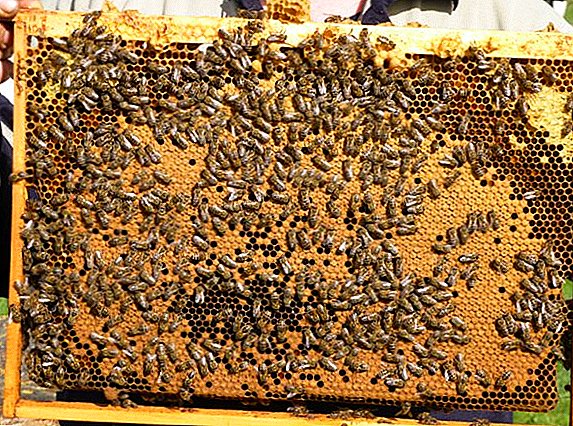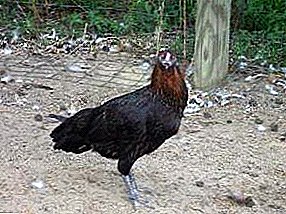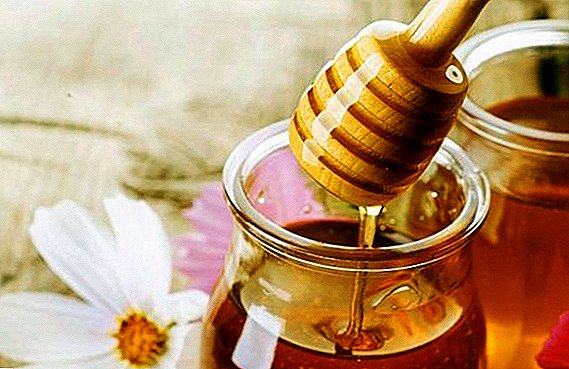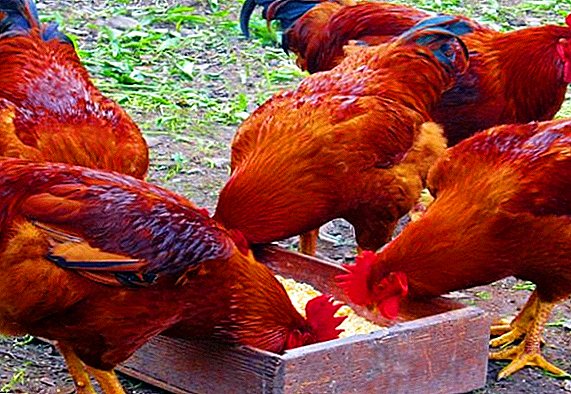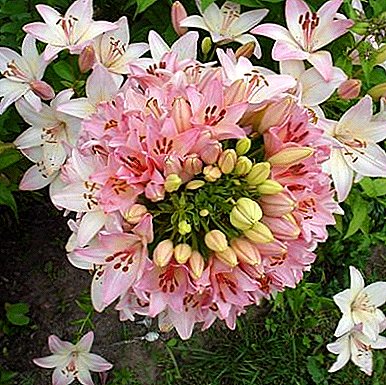
Lily Marlene, one of the most interesting plants of the lily family.
This is a hybrid of plants of the Asian group and long-flowered lilies - longiflorum (LA hybrid).
From the Asian group, this hybrid inherited early flowering, resistance to temperature fluctuations.
It is also distinguished by the absence of a sharp odor inherent in the plants of this family.
The second "parent" made the flowers larger and more elegant.
Description
 Outwardly, Lily Marlene looks like all lilies. Pale green stalks grow up to 90-100 cm in height. Long, pointed leaves up to 13 cm in length grow alternately.
Outwardly, Lily Marlene looks like all lilies. Pale green stalks grow up to 90-100 cm in height. Long, pointed leaves up to 13 cm in length grow alternately.
Pale pink flowers, turning pale in the middle, with rare dark red spots, are up to 15 in diameter. Root - the bulb, consisting of individual scales.
But an amazing feature of the Marlene variety is the ability to simultaneously produce up to one hundred flowers on one stem.
This property is called fasciation and is inherent not only to lilies, but also to other plants: several stems at the early stages of development grow together into one thick massive stalk with a huge amount of flower buds.
The reasons for such an anomaly are not fully identified, presumably this is due to mechanical damage to the sprouts or to the use of growth and flowering stimulants and bioregulators.
Undoubtedly, such a lush plant will adorn any garden!
Lilia Marlene photos:


On our site you can read articles about other types of lilies: Henry, Tacca Chantrier, Amazonian.
Not everyone has their own garden, so let's talk about growing Marlena Lily at home on the windowsill.
Home care
 Like all lilies, Marlene is quite unpretentious and does not require complex care.
Like all lilies, Marlene is quite unpretentious and does not require complex care.
If you pick up the planting time in advance and ensure the right conditions, you can get beautiful flowers at any time of the year - say, for an anniversary or a family celebration.
In autumn and winter, they plant bulbs for flowering in early spring, in spring - for flowering in summer, and if you plant a lily in early autumn, you can make it bloom even for a new year!
TIP: In the open ground, lilies reproduce virtually any part of them: bulbs, scales, bulbous bulbs formed in the leaf axils ... But for home flowers, it is better to buy ready-made bulbs - strong, healthy, weighing about 40 g.
Landing
The size of the pot is chosen according to the height of the plant: for our lily, about a meter high, a pot with a diameter of 30-35 cm and a depth of 25-30 cm will fit. We plant the bulbs at a distance of 4 cm from each other and at least 2.5 cm from the edge of the pot.
 Distillation of lilies begins with a stratification procedure — a rather abrupt change in temperature.
Distillation of lilies begins with a stratification procedure — a rather abrupt change in temperature.
This allows you to wake up the plant and "set" the date of flowering.
15-20 days of the bulb kept in the refrigerator at a temperature of about 5 ° C. After that, they are taken out, kept in a solution of potassium permanganate for 1-2 hours.
Then, about 12 hours soaked in a solution of nutrient fertilizers and growth stimulant and then planted in pots.
The soil
At the bottom we put 5 cm of drainage (river pebbles, expanded clay, foam pieces), then 10 cm of fertile land (peat neutral or slightly acid mixture), put the bulbs upside down on this layer and fill it with at least 10 cm of soil.
TIP: When planting, it should remain at least 7 cm to the edge of the pot: in the process of growth, additional roots appear that need to be sprinkled with earth.
Temperature conditions
Planted onions watered with warm water and ... again placed in the refrigerator for 3-4 weeks. The total stratification time is therefore 6-8 weeks. During this time, the plant takes root.
ATTENTION: Do not cover the pots with a film so as not to cause the multiplication of bacteria and fungi. If it is not possible to keep the pot in the refrigerator, it is enough to take it to a cool room.
When sprouts appear, the lilies are brought to a bright place with an air temperature of 12-15 ° C.
Young plants after 1 month are recommended to be hardened: take out to the balcony or fresh air, first for 30 minutes, then gradually increase the time to 10 hours a day, avoiding night cold below 10 ° C.
In urban apartments this is not always possible, so the lily grows well at room temperature.
Lighting
 Lilies - light-loving plants.
Lilies - light-loving plants.
If they lack natural light, it is recommended to use a fluorescent light.
Additional lighting is necessary if you want to get flowers in the "after-hour" time.
Better to put pots on the west or east side, avoiding direct sunlight.
Watering
Young shoots are watered not more often than once every three days - an excess of moisture can destroy the plant. In the first year of the lily usually do not bloom, but the bulb is gaining strength and gaining strength.
TIP: If the air in the room is overdried, the plants are sprayed from a spray bottle.
Lilies love fresh air, often ventilate the room.
As the flower grows, water more often and more abundantly, but make sure that there is no water left in the pan and moisture does not stagnate.
Feeding and stimulation
 The first top dressing with organic fertilizers is carried out after emergence of shoots.
The first top dressing with organic fertilizers is carried out after emergence of shoots.
During the period of leaf growth, nitrogen fertilizers are added, and with the appearance of buds, phosphorus-potassium. Processing plants with growth promoters (2 times a week) will increase the number of buds.
Earth should be regularly loosened to a depth of 5 cm, providing air flow to the roots.
Bloom
The flowers of this variety begin to bloom 75-80 days after the appearance of the first shoots.
An increase in temperature in the room, additional lighting and an increase in watering will speed up the flowering, and the beginning of flowering will slow down when the flower moves to a cold room.
This can be used for "custom" bouquets.
The most beautiful and strong flowers appear in the third year after planting, after 5-6 years of use the plant needs to be updated.
REFERENCE: Lily blossoms from 7 to 15 days, up to a dozen flowers appear on the plant. Fasciating in indoor conditions usually does not occur. Fading flowers are best removed immediately, so as not to weaken the bulb.
Trimming and transplanting
But all the buds have bloomed ... it's time to prepare the lily for a rest period.
Watering is reduced to 1 time per week, combining it with mineral supplements.
ATTENTION: Until all the stems are yellow and dry, transferring the nutrients to the bulbs, you cannot touch the plant.
Two weeks after the last leaf has dried, the bulbs should be dug out, cut off the remnants of the stalks, washed, held for 30 minutes in a weak solution of potassium permanganate, then dried, placed in moss or sawdust and stored in a dark cool place.
It’s better to put babies in a separate container right away - this is the best way to breed at home. Marlene, like an Asian hybrid, has little babies, and you can do without a transplant for several years.
Diseases and pests
 In the open ground lilies can be damaged by insects (lily beetle and its larvae, bears, wireworms, etc.).
In the open ground lilies can be damaged by insects (lily beetle and its larvae, bears, wireworms, etc.).
At home, there is practically no such danger.
The main enemy of the home lily is onion or bacterial rot - most often it comes from waterlogging.
The decayed bulbs and damaged leaves must be removed and destroyed, the remaining plant treated with anti-fungal drugs (Bordeaux liquid, phytosporin, etc.).
Benefit and harm
Lily as a home plant belongs to the most dangerous flowers. The reason - a sharp smell, causing allergies, headaches and insomnia. In this sense, Marlene favorably differs from her relatives: she practically does not smell.
ATTENTION: Do not put a flower in the bedroom or in the nursery. Lily flowers are toxic and dangerous to health!
With reasonable use, lily is certainly beneficial: its colors contain substances that help to get rid of freckles and age spots, whiten the skin and enhance its regeneration, and tea from dry petals removes slags and helps cleanse the blood. Of course, use flowers grown in the open air.
But even if you do not look for benefits in beauty, Lily Marlene will bring you joy and a sense of celebration at any time of the year.


